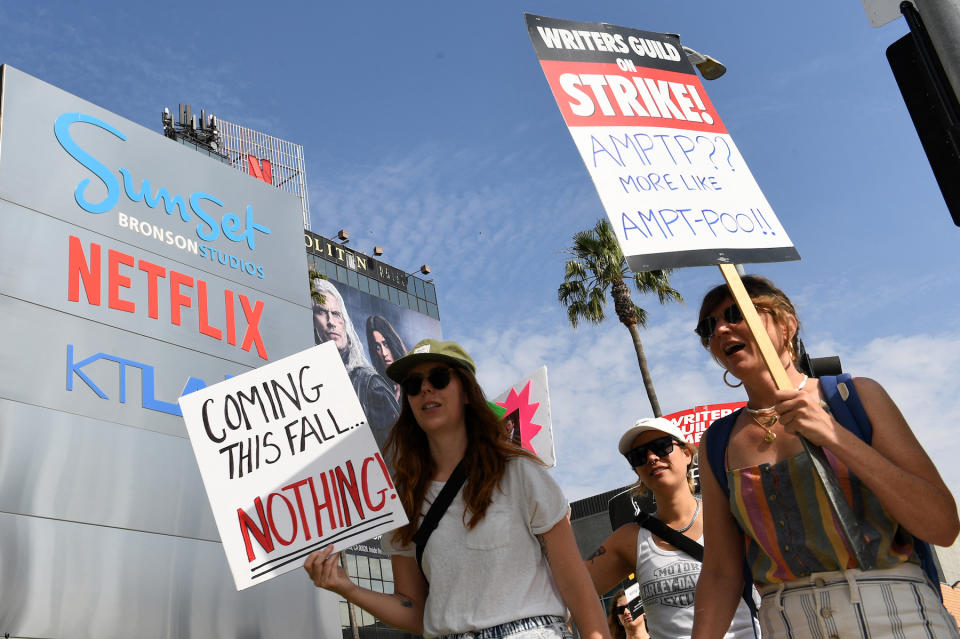SAG Actors Want Higher Residuals. Here’s How Streaming Residuals Work

SAG-AFTRA members have pressed pause on film and TV production for the past three weeks, aside from some greenlighted indie projects, in an effort to get Hollywood studios and streamers, or the Alliance of Motion Picture and Television Producers (AMPTP), to offer them a fair deal. Last week, the Writers Guild of America received a request from the AMPTP to reconvene negotiations after a more than three-month strike, and SAG-AFTRA members are hoping to be next. While calls for fair compensation, AI protections, revenue sharing, and updates to health care benefits are at the top of their list, there’s been a lot of discussion about residuals. Streaming services like Netflix and Hulu have transformed traditional pay scales, and residuals that once helped actors stay afloat between projects have often diminished to pennies.
For starters, residuals are payments performers receive for TV and film projects after initial compensation. An actor can expect a residual check once a show or movie re-airs on cable or a streaming service, or sells via DVD or VOD. For streamers like Max and Disney+, initial compensation covers the first 90 days a show or film is aired. Residuals are calculated using a formula based on year, time spent on set, production type, and where it will air. Residuals contain an interplay between how much a performer should get paid and the value of the production.
More from Rolling Stone
Seth Rogen Says There's Still a 'Great Distance to Go' Between Studios and Striking Actors
'Reservation Dogs' Revisits a Shameful Moment in American History
'Gilmore Girls' Actors Sound Off on Netflix Over Show's Streaming Residuals
Barry Gordon, a former SAG president and retired California State University media law professor, says that as streaming gained more prominence, factors like ratings and subscriber counts made it more difficult to determine how revenue should be distributed.
“It’s never going to be equivalent to what it was, right, just because it’s so diverse,” Gordon, who served as SAG president from 1988 to 1995, explains. “When it was three networks, it was pretty easy to know where that show was playing anytime it was playing.”

Prior to the streaming boom, actors would receive residual checks in waves. A person would first purchase a DVD or download the release of a film. The film would then trickle down to a paid TV channel and later become available on basic cable channels, otherwise known as syndication. On the other hand, if a show goes directly to streaming, SAG-AFTRA members do not receive multiple residual checks.
“That’s the only payment you get for a whole year,” a SAG-AFTRA spokesperson tells Rolling Stone. “And then the next year you get that one payment again, but it’s a little smaller. It’s a decreasing payment once per year, if you’re talking about shows that are made for Netflix or made for Disney+ or made for Hulu. So that’s the big difference.”
One of Brendan Bradley’s first jobs was as a co-star on the CBS hit series NCIS, and he says residual checks would get him through moments when he didn’t have consistent work. Bradley, a SAG member since 2006, says he remembers opening one of his first residual checks for $1,000 in 2014.
“I broke down crying because it was how I was going to be able to cover some of my rent,” Bradley says.
With the shift to streaming, Bradley says residuals have largely evaporated. Sylvia Batey Alcalá, a SAG member since 2008, has received meager residuals for streaming services, like Amazon Freevee, as well. It’s frustrating, she says, because the industry isn’t transparent when it comes to its metrics for determining success. As Oscar-winning filmmaker and TV creator Steven Soderbergh recently told Rolling Stone, “It’s impossible to figure out what’s fair if you don’t know what’s real.… They will not open the books, so how do you figure out what’s fair if you don’t know what’s going on?”
Performers, professional singers, stunt performers, stunt coordinators, and pilots are entitled to residuals, whereas background actors are not. One of SAG-AFTRA’s proposals, released in a July 13 negotiation-status chart, included improved residuals for the re-airing of movies and TV shows on subscription-based streaming services. The chart revealed that SAG-AFTRA has made progress in these negotiations with Hollywood studios and streamers, but “significant gaps remain.” The AMPTP countered that their producers’ offer included a 22 percent residual increase for Prime Video, Disney +, Hulu, and Netflix.
“We’re fighting not just for ourselves,” offers Batey Alcalá, “but for the future of the industry.”
Best of Rolling Stone

